Rhode Island, with its diverse landscapes and abundant natural beauty, is home to more than 400 types of birds.
Although it’s a tiny state, there are plentiful habitats for a wide range of birds. There are meadows, wetlands, coastal marshes, forests, fields, and not to mention backyards with feeders. We wrote a Bird Guide about Rhode Island that features many of the state’s most interesting birds, including:
- Cardinals
- Woodpeckers
- Hummingbirds
- Jays
- Grackles
- Nuthatches
- Ducks
- Warblers
- Crows
- and more
Among the many avian residents in Rhode Island’s wetlands, forests, and coastal areas, sparrows hold a special place.
These small, yet charismatic birds sometimes get overlooked – but shouldn’t be! Not only is each type of sparrow slightly different from every other kind, but they are also a great challenge for birders.
Let’s dive into the world of sparrows in Rhode Island – starting with an exploration of what makes a sparrow a sparrow in the first place!
What Makes a Sparrow a Sparrow?
Sparrows are sometimes called “Little Brown Jobs.” LBJs got that nickname from the fact that they are small, mostly brown birds that look a lot alike and have similar behaviors.
All sparrows belong to the family Passeridae, which is part of the diverse order Passeriformes. These small passerine birds are renowned for their seed-eating habits and characteristically short, pointed beaks, which are adapted for cracking open seeds and foraging on the ground.
They tend to be between 5 and 7 inches long and are usually marked with dark or light streaking on their wings, back, and chest. Their facial markings are often one of the best ways to tell the difference between them.
How to Identify Sparrows
When it comes to identifying sparrows in Rhode Island, paying attention to specific features and field marks is crucial. Here are some key characteristics to look for when observing sparrows in the field:
- Plumage Coloration & Patterns: Sparrows exhibit a range of colors, including shades of brown, gray, and white. Look for distinctive patterns such as streaks, spots, or stripes on their heads, backs, chests, and wings. Males and females tend to be pretty similar in appearance, although there is some sexual dimorphism in some breeds.
- Facial Markings: Focus on the facial features of sparrows for the best fast insight into which one is which. Some species have distinct eye lines, eyerings, or contrasting colors on their cheeks and throats. These markings can vary in intensity and provide essential clues for identification.
- Bill Shape and Size: Observe the shape and size of the sparrow’s bill. It can range from short and conical to long and slender, depending on the species. Most sparrows’ bills are pretty short and sharp, but there will be some variations to take note of. Also, pay attention to the bill’s coloration and any specialized adaptations for feeding.
- Tail Length and Shape: Sparrows have diverse tail lengths and shapes. Some species may have square-ended tails, while others exhibit notched or rounded tails. Note any distinctive tail patterns or markings.
- Wing Bars and Wingtips: Look for wing bars, which are contrasting markings across the wings. Some sparrows have bold wing bars, while others may show subtle or absent wing bars. Also, observe the coloration and patterns on the wingtips.
- Size and Body Shape: Take note of the sparrow’s overall size and body proportions. Compare its size to other sparrows and nearby birds to get a better sense of its relative dimensions. Consider body shape, whether it appears plump, slim, or somewhere in between.
By focusing on these key characteristics and field marks, you can enhance your ability to identify sparrows in Rhode Island accurately. Remember to consult field guides or reliable resources (like Wild Bird Scoop!) for specific details on each sparrow species, as well as regional variations in plumage and behavior.
How Many Sparrows Are in Rhode Island?
There are a lot of sparrows in Rhode Island! Even though it is a small state, there are plenty of sparrows that spend time here – either all year long, just for the summer or winter, or while they migrate.
Our list includes 20 sparrows and sparrow-like birds that you are likely to find in Rhode Island. We have divided the list into four categories, based on when you can find these birds in the state.
Because Rhode Island is only about 1,200 square miles in area, most sparrows that are found here are not limited to one area of the state (in other states, you might have a sparrow that visits the western half but never visits the eastern half at all).
Our list includes the bird’s scientific name, order and family, its size dimensions (length, weight, and wingspan), and information about its appearance, diet, location, and interesting behaviors.
Let’s get started!
Sparrows in Rhode Island All Year Long
There are several sparrows who live in Rhode Island all year. Keep in mind that when you look at the list of summer and winter sparrows, you can also find each of these year-round sparrows. they are the Horned Lark, the House Sparrow, the Saltmarsh Sparrow, the Song Sparrow, the Swamp Sparrow, and the White-throated Sparrow.
Horned Lark
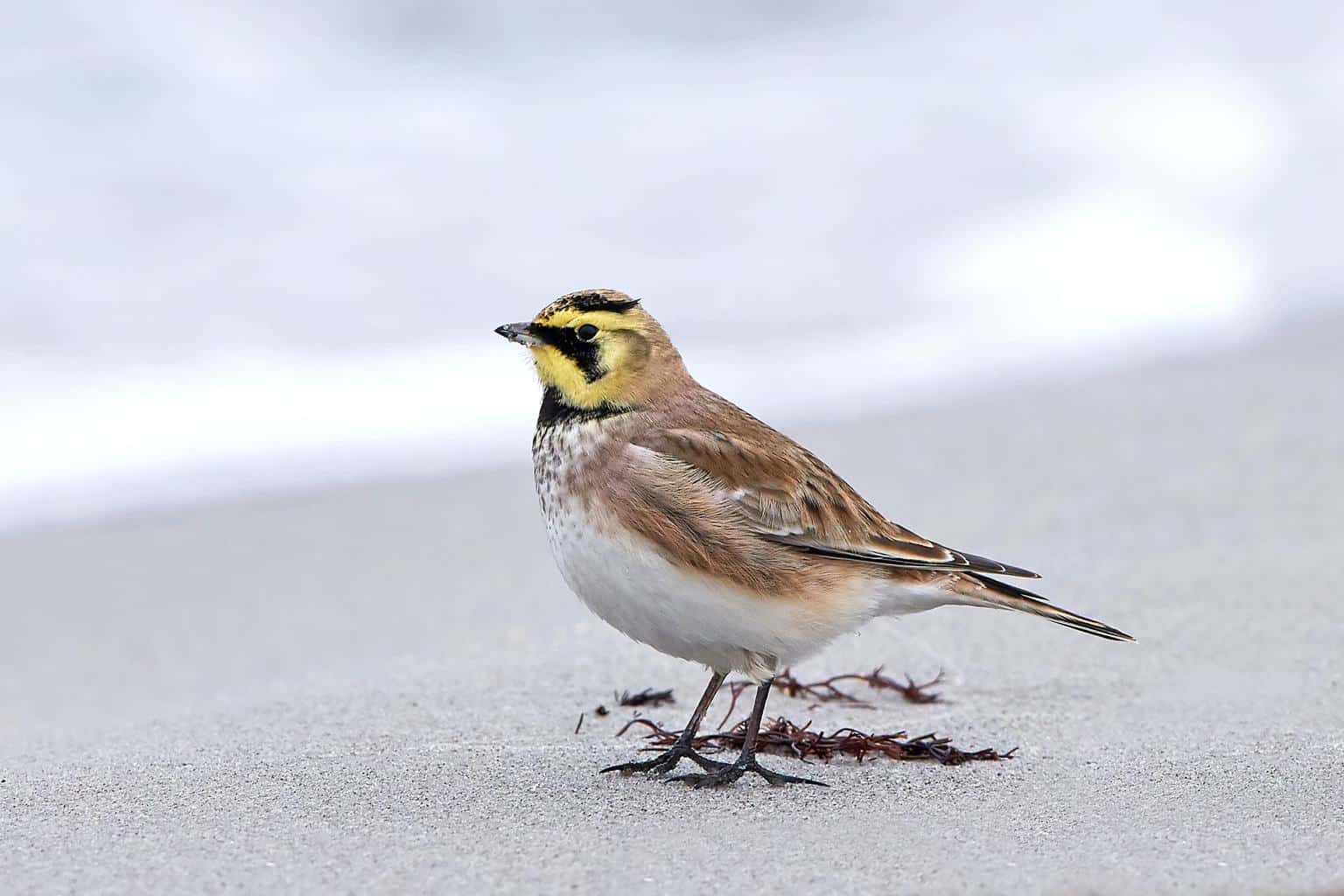
- Scientific name: Eremophila alpestris
- Order: Passeriformes
- Family: Alaudidae
- Length: 5.5-7.1 in (14-18 cm)
- Weight: 0.8-1.5 oz (22-43 g)
- Wingspan: 10.6-11.4 in (27-29 cm)
Horned Larks are a fascinating species found in Rhode Island, thriving in a variety of open habitats across the state. These small passerines are known for their striking black “horns” on the sides of their head, which make them easily recognizable.
In Rhode Island, Horned Larks can be observed year-round in fields, grasslands, agricultural areas, and even coastal dunes. Their preferred habitats are characterized by open spaces with sparse vegetation, enabling them to forage for seeds and insects with ease.
These resilient birds have also been known to occupy barren landscapes such as gravel pits and airports, showcasing their ability to adapt to human-altered environments.
Female Horned Larks have an interesting habit. When they build their nests, they also collect pebbles, corncobs, dung, and other paving materials, which they place outside of their nests and cover in soil they dug out of their nest cavity. It’s a bit like a paved sidewalk leading up to the nest! That said, they don’t actually use it like a sidewalk, and no one knows for sure what these pavings do.
House Sparrow
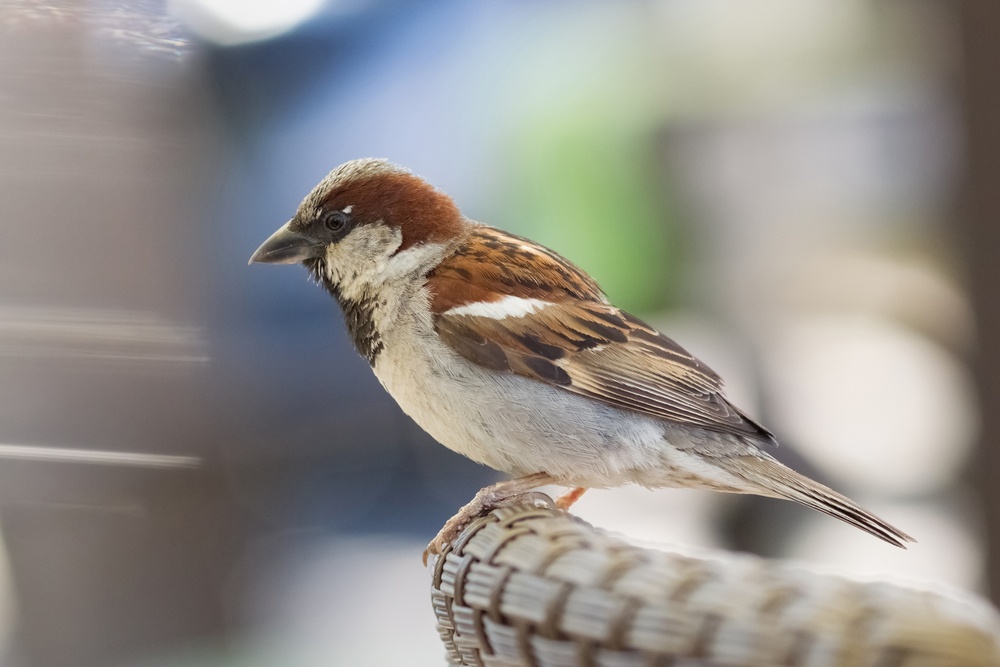
- Scientific name: Passer domesticus
- Order: Passeriformes
- Family: Passeridae
- Length: 5.9-6.7 in (15-17 cm)
- Weight: 0.9-1.1 oz (27-30 g)
- Wingspan: 7.5-9.8 in (19-25 cm)
House Sparrows are a common sight in Rhode Island all year long, adapting to human-dominated landscapes throughout the state. These resilient birds have established themselves as a part of the local avian community, despite being non-native. This is due to their successful breeding and competitive nature, often out-competing native bird species for nesting sites and food resources.
The male House Sparrow has a rufous-colored neck, a black bib, white cheeks, and a gray head. In contrast, the female displays predominantly brown plumage with black stripes on her back and wings.
While House Sparrows typically avoid fields, forests, mountains, and deserts, they have managed to thrive in Rhode Island’s urban and suburban environments by seeking out human structures as their preferred nesting locations.
These adaptable birds are known to build their nests in a variety of settings, from the rafters and roofs of residential buildings to outbuildings and even high-rise skyscrapers in urban areas. Their presence in secluded areas with vast stretches of wilderness surrounding them demonstrates their resourcefulness in seeking out suitable nesting opportunities – they will find a building to live near even if it is far away from anything else!
Saltmarsh Sparrow
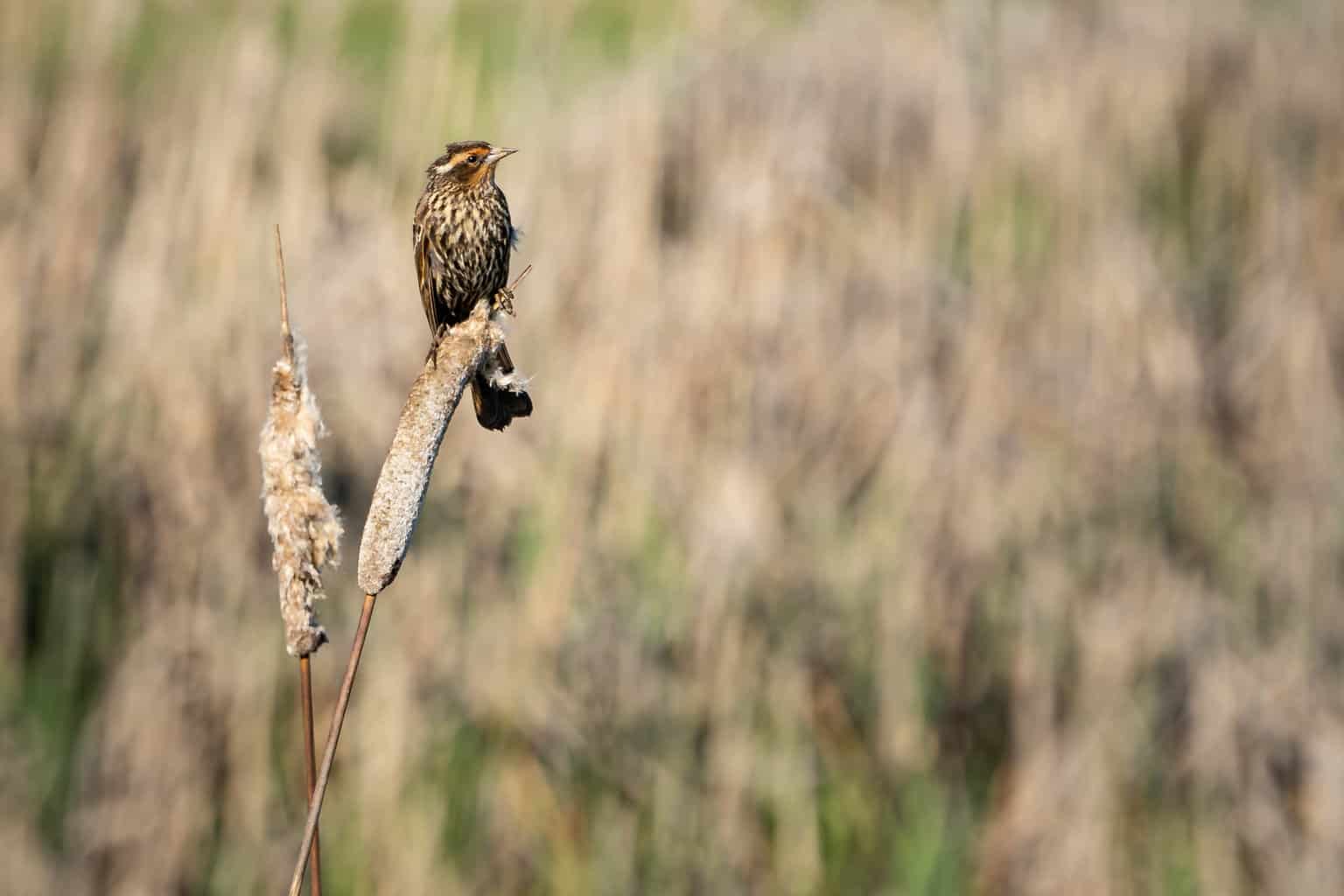
- Scientific name: Ammospiza caudacuta
- Order: Passeriformes
- Family: Passerellidae
- Length: 4.7-5.5 in (12-14 cm)
- Weight: 0.3-0.5 oz (10-14 g)
- Wingspan: 6.7-7.9 in (17-20 cm)
The Saltmarsh Sparrow is an exclusively coastal bird that can be found in Rhode Island’s salt marshes and coastal habitats. This small, secretive bird is highly adapted to its unique environment, with a slender body and a pointed bill that allows it to navigate through the dense marsh vegetation.
They are medium-distance migrants. Rhode Island is right in the middle of its summer and winter territories, which means there are Saltmarsh Sparrows here year-round. Some of the sparrows you see here are at the southern edge of their breeding ground; others are at the northern edge of their winter territory.
Saltmarsh Sparrows are known for their distinctive song, which carries across the marshes during the breeding season.
These birds are expert nest builders, constructing their cup-shaped nests hidden within the tall grasses and reeds of the salt marshes. Their nests will even get overtaken with water from time to time, but as long as the eggs aren’t washed away, this is fine.
However, the Saltmarsh Sparrow faces significant conservation challenges due to the loss and degradation of its preferred salt marsh habitats.
Song Sparrow

- Scientific name: Melospiza melodia
- Order: Passeriformes
- Family: Passerellidae
- Length: 4.7-6.7 in (12-17 cm)
- Weight: 0.4-1.2 oz (12-34 g)
- Wingspan: 7.9-9.8 in (20-25 cm)
The beautiful song of the Song Sparrow can be heard resonating across Rhode Island’s diverse landscapes all year long. These medium-sized sparrows are known for their beautiful songs, with each male Song Sparrow having its own unique variation. Their vocal talents, combined with their intricate brown plumage adorned with streaks and blotches, make them a delightful sight and sound in the state.
This is a medium-sized sparrow with a plump body and a rounded head. It has a brown back with streaks and a grayish breast with dark brown streaks that converge into a central spot on the chest. Its face is adorned with a white eyebrow stripe and a brown malar stripe. The bird’s bill is thin and pointed, perfect for foraging and capturing insects or seeds.
Song Sparrows are versatile birds, inhabiting a wide range of habitats including wetlands, shrubby areas, gardens, and forest edges. They build their nests low in dense vegetation, creating cup-shaped structures carefully woven from grasses and twigs.
Swamp Sparrow

- Scientific name: Melospiza georgiana
- Order: Passeriformes
- Family: Passerellidae
- Length: 4.7-5.9 in (12-15 cm)
- Weight: 0.6-0.9 oz (18-26 g)
- Wingspan: 6.7-7.9 in (17-20 cm)
In Rhode Island’s wetlands, you can hear Swamp Sparrows throughout the year, although they are most vocal during the breeding season. These small birds thrive in marshy habitats, making them a recognizable species of the state’s wetland ecosystems. Their unique coloration serves as excellent camouflage among the dense vegetation, allowing them to blend seamlessly into their surroundings.
The Swamp Sparrow is a small, chunky sparrow with a short tail. It has rich brown plumage with dark streaks throughout, giving it a heavily patterned appearance. Its face is adorned with a grayish-brown crown and a distinctive reddish-brown cap. The bird has a white throat, which contrasts with the brownish-gray breast and sides. Its bill is short and thick, allowing it to efficiently forage in wetland habitats.
Swamp Sparrows build their nests near the ground, often hidden among grasses and cattails. Despite their preference for wetlands, these adaptable sparrows can also be found in shrubby areas and along forest edges.
White-throated Sparrow

- Scientific name: Zonotrichia albicollis
- Order: Passeriformes
- Family: Passerellidae
- Length: 6.3-7.5 in (16-19 cm)
- Weight: 0.9-1.2 oz (25-34 g)
- Wingspan: 7.9-9.1 in (20-23 cm)
The White-throated Sparrow is found year-round in Rhode Island’s woodlands. It is a medium-sized sparrow with an elegant appearance. It features a striking black-and-white striped crown on its head, which contrasts with its gray face and neck. Its back is brown with darker streaks, and its underparts are a warm buff color.
As its name suggests, the bird has a white throat patch that extends into a crisp white belly. Its bill is pinkish and conical in shape, ideal for cracking open seeds.
White-throated Sparrows are primarily ground foragers, feeding on seeds, berries, insects, and small invertebrates. They also build their nests on or near the ground, concealed among shrubs and low vegetation.
These sparrows are commonly found in mixed deciduous and coniferous forests, where their songs reverberate through the trees during the breeding season.
Sparrows in Rhode Island in the Summer
Rhode Island offers excellent breeding grounds for several kinds of sparrows. These birds arrive in the spring and stay through the summer, finding mates, building nests, and raising their fledgling babies. This includes the Chipping Sparrow, the Grasshopper Sparrow, the Eastern Towhee, the Savannah Sparrow, the Seaside Sparrow, and the Vesper Sparrow.
Chipping Sparrow
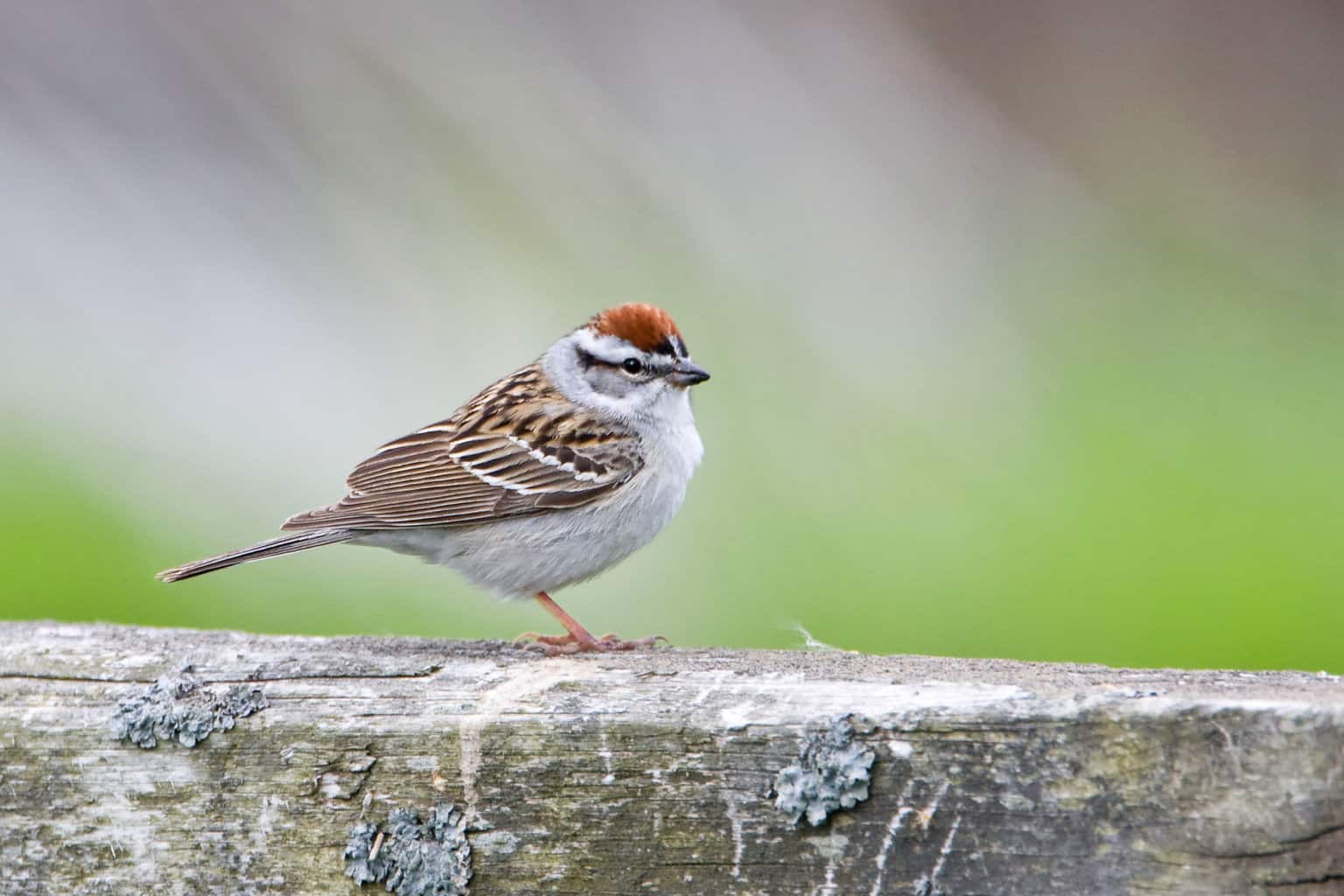
- Scientific name: Spizella passerina
- Order: Passeriformes
- Family: Passerellidae
- Length: 4.7-5.5 in (12-14 cm)
- Weight: 0.4-0.6 oz (12-18 g)
- Wingspan: 7.5-8.7 in (19-22 cm)
During the summer, you can hear the Chipping Sparrow’s cheerful song in both the woods and many neighborhoods. The Chipping Sparrow is a small sparrow with a slender body and a round head. It has a warm brown back and wings, and its crown is adorned with a rusty red cap. The bird’s face is marked with a grayish-white eyebrow stripe, and it has a clean white belly. Its bill is short and pointed.
Chipping Sparrows can most often be found foraging on the ground, feeding on seeds, insects, and berries. They are known for their affinity for open spaces with scattered trees, making them common visitors to parks, gardens, and forest edges throughout the state.
Nesting in trees and shrubs, Chipping Sparrows build cup-shaped nests delicately woven from grasses and other plant materials.
Eastern Towhee

- Scientific name: Pipilo erythrophthalmus
- Order: Passeriformes
- Family: Passerellidae
- Length: 6.8-8.2 in (17-21 cm)
- Weight: 1.1-1.8 oz (32-51 g)
- Wingspan: 7.9-11 in (20-28 cm)
The Eastern Towhee is one of the more unique-looking birds on our list, with its striking black upperparts, rusty flanks, and red eyes. The underparts are a rich rusty color, contrasting with the black upperparts. The female has a more subdued appearance, with brown tones instead of black. The Eastern Towhee has a thick, conical bill, well-suited for foraging in leaf litter and scratching the ground.
It is found in the summer breeding months in Rhode Island’s woodlands, thickets, and shrubby areas.
They are ground-dwelling birds that forage for insects, seeds, and berries among fallen leaves and dense vegetation. Males sing a distinctive “drink-your-tea” song, while both males and females make a sharp “chewink” call that adds a touch of wilderness to the state’s natural symphony.
These charismatic birds build their nests on the ground, well-hidden beneath shrubs or in leaf litter. Towhees will sometimes go to backyard feeders for high-quality millet feed, but they will often forage on the ground instead of actually visiting the feeder.
Grasshopper Sparrow
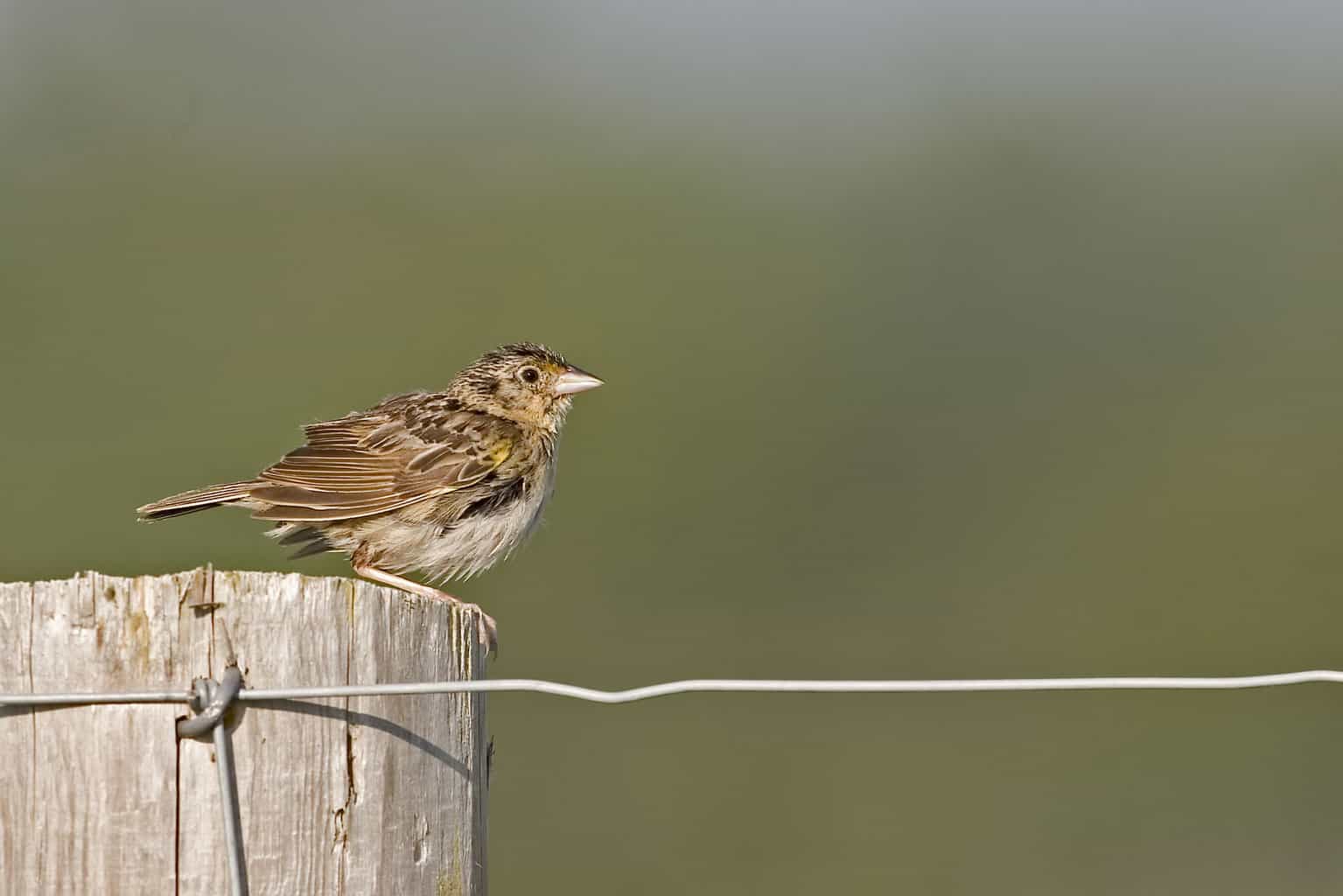
- Scientific name: Ammodramus savannarum
- Order: Passeriformes
- Family: Passerellidae
- Length: 4.3-5.1 in (11-13 cm)
- Weight: 0.4-0.5 oz (11-14 g)
- Wingspan: 7.1-7.9 in (18-20 cm)
The Grasshopper Sparrow is a very stealthy little bird. It has a compact body and a short tail, and it displays intricate patterns of brown, buff, and gray on its upper parts. The bird’s face has a pale yellow stripe over the eye, and it has a buffy throat and breast. Its belly is white, and it has dark streaks on the sides. The Grasshopper Sparrow’s bill is small and thin, adapted for capturing insects in open grassy habitats
Grasshopper Sparrows are known for their insect-like buzzy songs, which are more likely to be heard in the summer than at any other time of year. That’s when males perch and sing. They forage on the ground, choosing to run instead of fly. They prey on insects and occasionally feed on seeds.
Building their nests on the ground, often hidden in clumps of grass, these sparrows display remarkable adaptability to open habitats.
Savannah Sparrow

- Scientific name: Passerculus sandwichensis
- Order: Passeriformes
- Family: Passerellidae
- Length: 4.7-6.7 in (12-17 cm)
- Weight: 0.6-1 oz (18-28 g)
- Wingspan: 7.9-9.8 in (20-25 cm)
The Savannah Sparrow, with its streaked brown and gray plumage, is a common summer sight in Rhode Island’s coastal habitats and grasslands. These small sparrows exhibit a subtle beauty, blending in perfectly with their preferred environments.
The Savannah Sparrow is a small sparrow with a slender body and a slightly rounded head. It has a mixture of brown, gray, and buff plumage on its back, wings, and tail. The bird’s face has a pale yellow stripe over the eye, and it has a white throat and belly. Its breast is streaked with fine dark markings. The Savannah Sparrow has a small, pointed bill.
Savannah Sparrows forage on the ground, feeding on seeds, insects, and small invertebrates. They are often found in salt marshes, meadows, and coastal dunes, showcasing their adaptability to both wet and dry habitats. These sparrows are known for their sweet, high-pitched songs that can be heard during the breeding season.
Seaside Sparrow

- Scientific name: Ammospiza maritima
- Order: Passeriformes
- Family: Passerellidae
- Length: 4.7-5.9 in (12-15 cm)
- Weight: 0.6-0.9 oz (18-26 g)
- Wingspan: 7.1-8.3 in (18-21 cm)
The Seaside Sparrow is a fascinating bird that thrives in Rhode Island’s coastal marshes and tidal salt marshes. It is a small sparrow with a sturdy build and a short tail. It has a rich brown plumage with intricate streaks and mottling, allowing it to blend seamlessly with its marsh habitat.
The bird’s face has a pale stripe over the eye, and it has a pale throat and breast that transition to a buffy color on the belly. The Seaside Sparrow’s bill is medium-sized and pointed, suited for foraging among the marsh grasses and reeds.
Seaside Sparrows are highly adapted to their specialized habitat, foraging for insects and seeds among the dense vegetation of the marshes. They are remarkable builders, constructing their nests in the marsh grasses, often woven into the sturdy stems to withstand the tides.
They do not travel inland; you will only see the Seaside Sparrow on the coast.
Vesper Sparrow
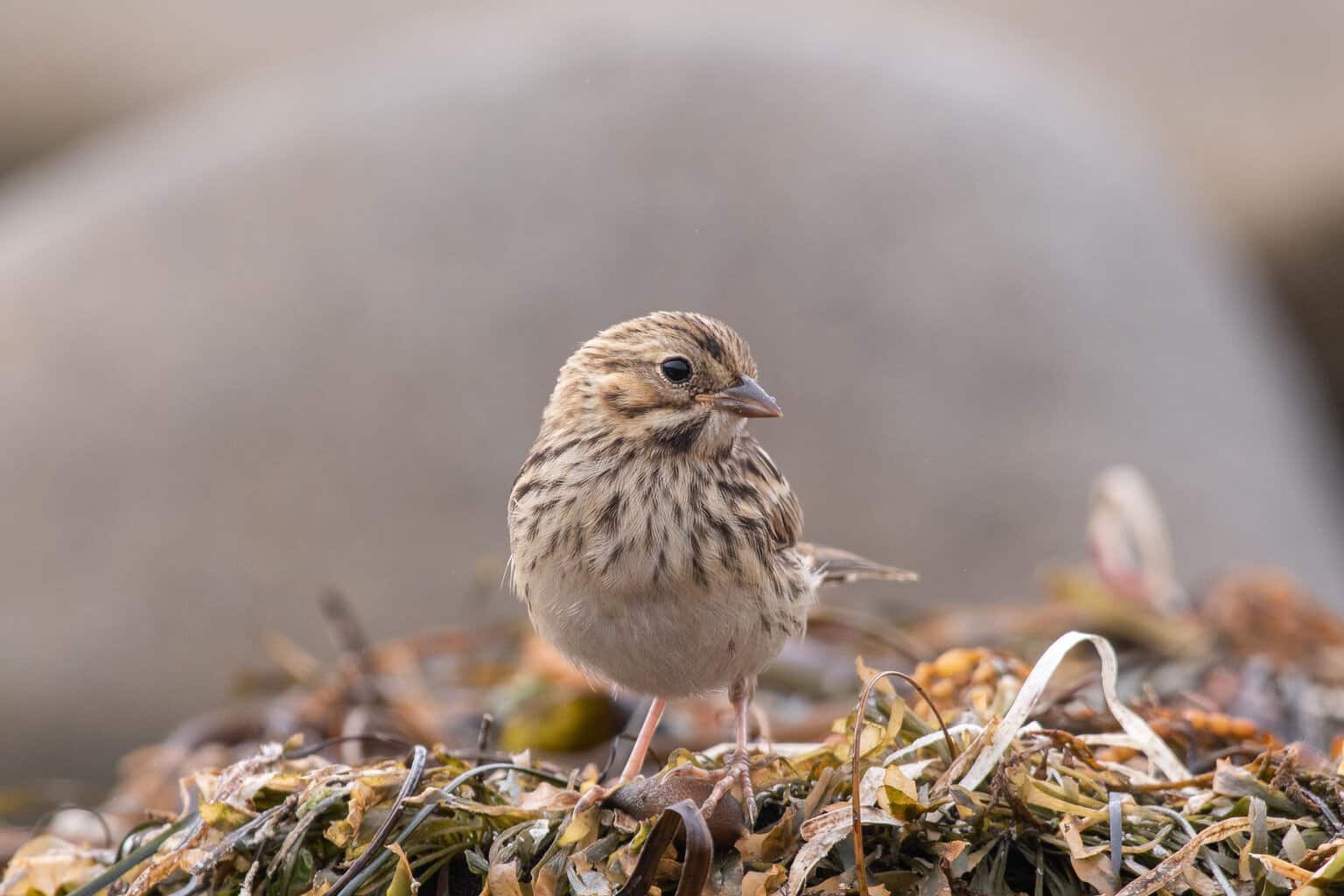
- Scientific name: Pooecetes gramineus
- Order: Passeriformes
- Family: Passerellidae
- Length: 5.9-6.7 in (15-17 cm)
- Weight: 0.7-1 oz (20-29 g)
- Wingspan: 9.1-10.2 in (23-26 cm)
The Vesper Sparrow sings a lovely song, especially in the evening. In fact, it gets its name from its sundown song, which is the same time as some Christian traditions hold a vesper prayer service.
This is a medium-sized sparrow with a slim body and a long tail. It shows off a combination of brown, gray, and buff plumage on its upper parts, creating a finely streaked pattern. Its face has a pale stripe over the eye, and it has a buffy throat and breast. The belly is white with subtle dark streaks. The Vesper Sparrow has a slender bill.
Vesper Sparrows are ground-dwelling birds that forage for seeds and insects in open grassy areas. They are often found in fields, meadows, and prairies, where their lovely songs fill the air during the twilight hours. These sparrows build their nests on the ground, often hidden beneath clumps of grass or in small depressions.
Sparrows in Rhode Island in the Winter
We’re ready to move on to our next group of sparrows: those that visit Rhode Island for the winter! These birds arrive in Rhode Island in the fall, and they stay until spring. Unfortunately, sparrows are less vocal in the winter, so you are less likely to hear their distinctive songs in the winter. The sparrows that visit Rhode Island every winter are the American Tree Sparrow, the Dark-eyed Junco, the Fox Sparrow, and the Lapland Larkspur.
American Tree Sparrow
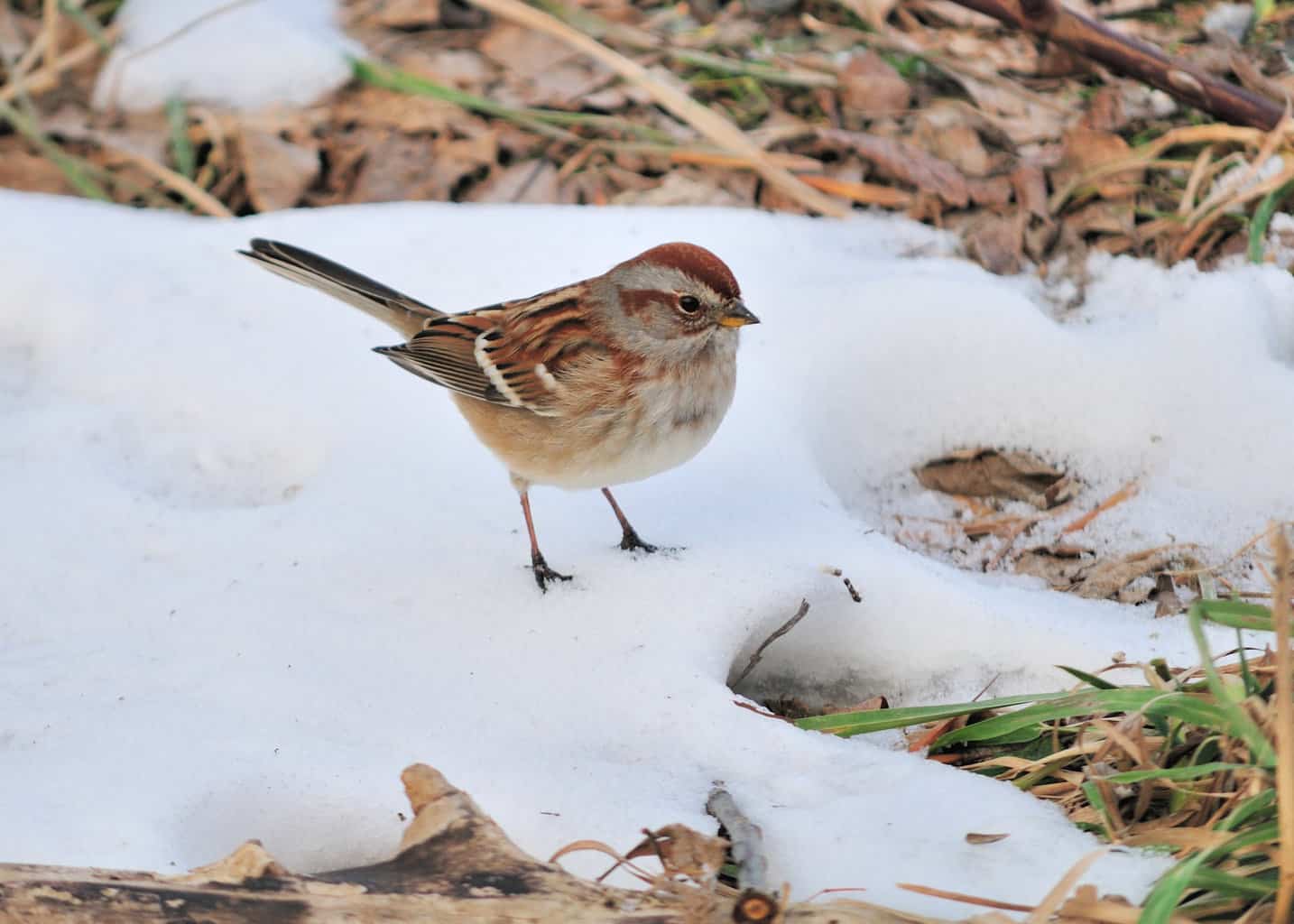
- Scientific name: Spizelloides arborea
- Order: Passeriformes
- Family: Passerellidae
- Length: 5.1-6.3 in (13-16 cm)
- Weight: 0.6-0.9 oz (18-26 g)
- Wingspan: 7.9-9.4 in (20-24 cm)
The American Tree Sparrow is a charming small sparrow that can be found across Rhode Island’s woodlands and shrubby areas during the winter months. They are incredibly well adapted to very cold environments, as they breed in the northern Canadian tundra.
This bird has a combination of warm brown and gray plumage with a rusty-red cap on its head. These sparrows forage on the ground, feeding on seeds, berries, and insects. They are known for their sweet melodic songs.
Their name came from the fact that they looked like the Eurasian Tree Sparrows, at least to the European settlers who gave them their names. However, American Tree Sparrows are not tree-dwellers. Rather, they are almost always on the ground, including their nesting and foraging habits.
Dark-eyed Junco
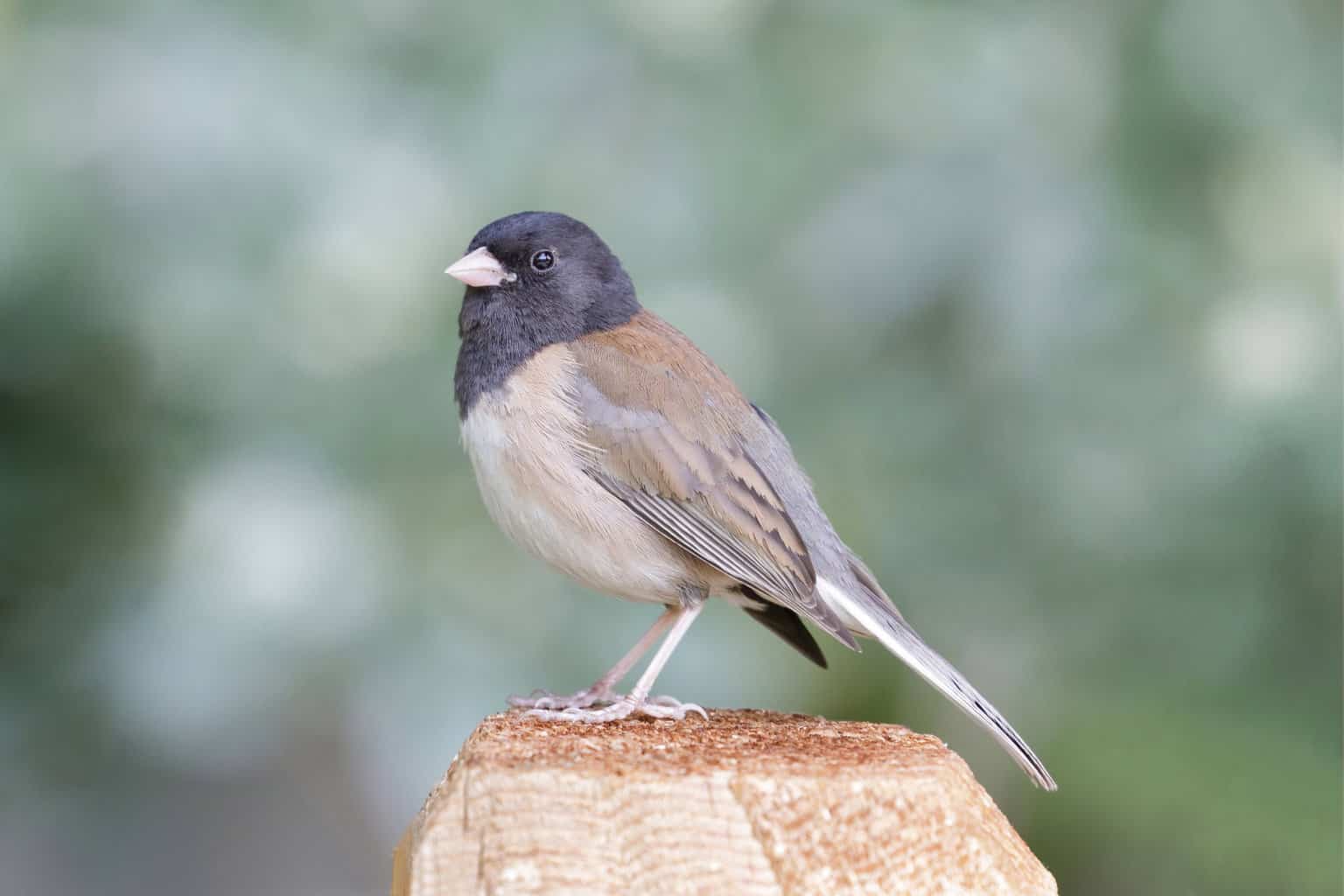
- Scientific name: Junco hyemalis
- Order: Passeriformes
- Family: Passerellidae
- Length: 5.1-6.3 in (13-16 cm)
- Weight: 0.7-1 oz (20-28 g)
- Wingspan: 7.5-9.8 in (19-25 cm)
The Dark-eyed Junco is a plump little sparrow that is strongly associated with winter in much of North America. They are among the birds that are called “Snowbirds,” as they are so commonly spotted at snowy backyard bird feeders.
Different subspecies of Dark-eyed Juncos exhibit a range of colors, including shades of gray, brown, and even reddish-brown. In Rhode Island, they are mostly slate gray and white-bellied.
They frequent Rhode Island during the colder months and are found throughout the state. They are one of the most plentiful birds in North America. Other than the Florida peninsula and the coast of Louisiana, Dark-eyed Juncos are found in every contiguous US state and Alaska.
Dark-eyed Juncos are ground foragers who are known for hopping back and forth for seeds. They spend the winter in large flocks, so don’t be surprised if you see them with lots of other Dark-eyed Juncos.
Fox Sparrow

- Scientific name: Passerella iliaca
- Order: Passeriformes
- Family: Passerellidae
- Length: 6.7-7.9 in (17-20 cm)
- Weight: 1-1.6 oz (28-45 g)
- Wingspan: 10.6-11.8 in (27-30 cm)
The Fox Sparrow is a captivating songbird that visits Rhode Island during the winter. With its robust build and rich, rusty plumage, this medium-sized sparrow stands out and is easier to recognize than several other sparrows.
There is a lot of regional variation in Fox Sparrows. Sometimes, they are mostly reddish-brown, and other times, they have just a little bit of reddish-brown streaking. They are sexually monomorphic, meaning that there is no significant difference between the appearance of males and females.
Fox Sparrows have thick, sturdy legs and are known for kicking around the leaf litter on the ground as they forage. You may actually see the litter flying before you even see the bird!
Fox Sparrows have a pretty song that is a lot like a whistle. Their call is more of a smack sound.
Lapland Longspur

- Scientific name: Calcarius lapponicus
- Order: Passeriformes
- Family: Calcariidae
- Length: 5.5-6.7 in (14-17 cm)
- Weight: 0.9-1 oz (26-28 g)
- Wingspan: 11.4-12.6 in (29-32 cm)
The Lapland Longspur is an intriguing visitor to Rhode Island’s open fields and coastal areas during the winter months. It is a sparrow-like bird that breeds in the farthest northern reaches of Canada and Greenland, then migrates into most of the US for the winter.
The Lapland Longspur is a medium-sized sparrow with a length ranging from 5.5 to 6.7 inches. It has a distinctive appearance, with a black face, chest, and belly that contrasts with its rusty-brown back. The plumage is relatively plain, lacking bold patterns or markings. The beak is small and pointed, suitable for foraging on the ground. Overall, the Lapland Longspur has a sleek and compact build, with colors that blend well with its natural habitat.
Females and nonbreeding individuals have a more subdued appearance, with sandy-brown plumage and streaked patterns.
Lapland Longspurs are adept foragers, feeding primarily on seeds and occasionally insects. They are known for their beautiful, jingling songs, performed while in flight. These sparrows build their nests on the ground, cleverly hidden in grassy areas and lined with grasses and plant fibers.
Sparrows That Migrate Through Rhode Island
There are a handful of sparrows and sparrow-like birds that migrate through Rhode Island every spring and winter as they move between summer and winter territories. These are the American Pipet, the Dickcissel, the Lincoln’s Sparrow, and the White-crowned Sparrow.
American Pipit
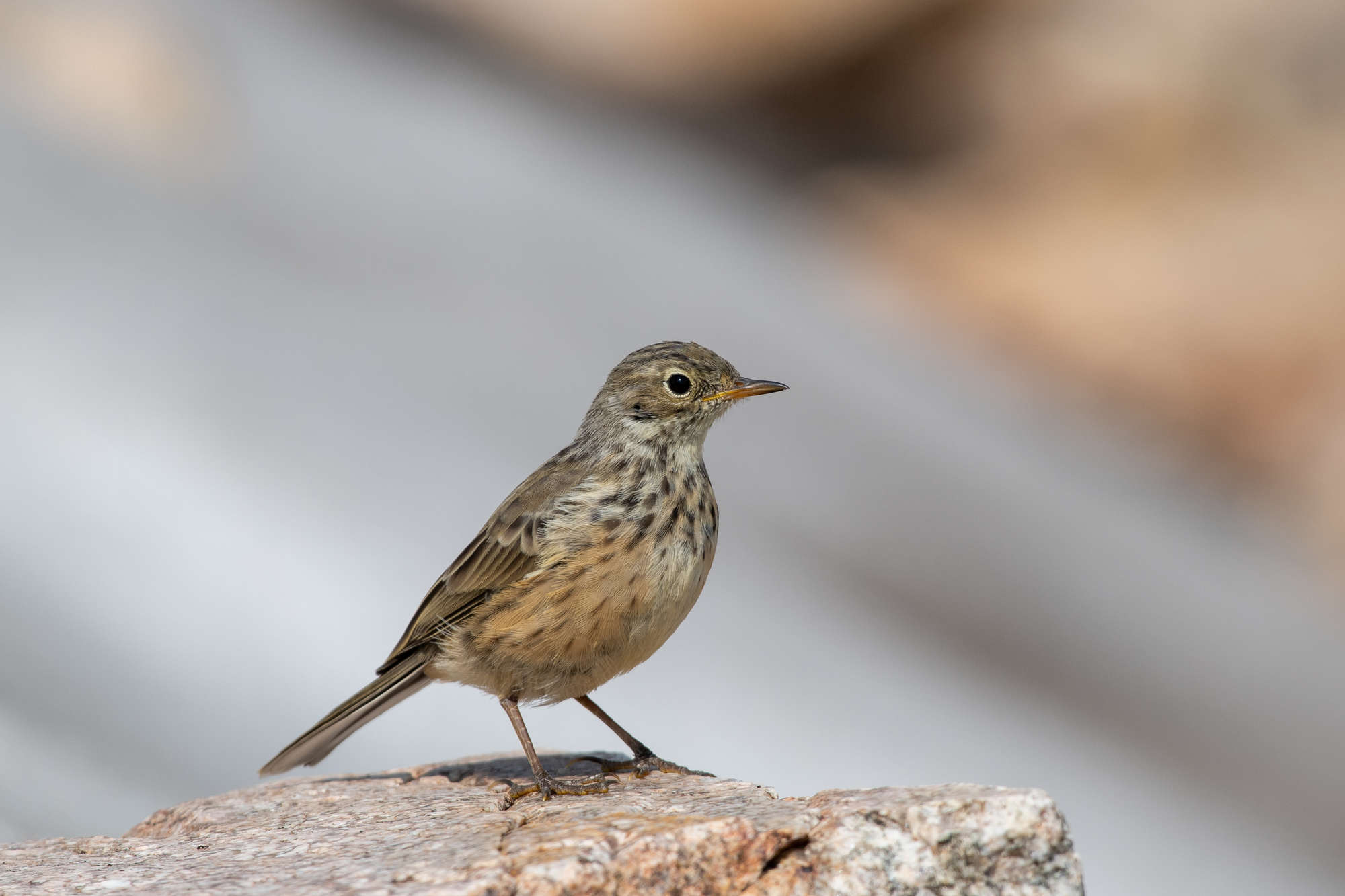
- Scientific name: Anthus rubescens
- Order: Passeriformes
- Family: Motacillidae
- Length: 6-7 inches (15-18 cm)
- Wingspan: 10-11 inches (25-28 cm)
- Weight: 0.8-1.0 oz (23-28 g)
The American Pipit, scientifically known as Anthus rubescens, is one of the rarer birds on this list.
It is a slender and medium-sized sparrow-like bird that is characterized by a blend of brown, gray, and white plumage, with a predominantly brown back and pale underparts streaked along the sides. This pipit species exhibits a relatively long tail that it frequently wags up and down while foraging on the ground. Sporting a thin and pointed bill, the American Pipit skillfully probes the soil for insects and seeds, showcasing its remarkable adaptability.
This species of pipit is known for its extensive migratory habits. During the breeding season, they can be found in the northern regions of North America, including Alaska and Canada. However, when winter approaches, American Pipits undertake long-distance migrations to more temperate regions, such as coastal areas and grasslands. They sometimes pass through Rhode Island as part of their migratory journey.
If you are lucky enough to encounter an American Pipit, it is likely to be found in open fields, grasslands, and sometimes even coastal areas.
Dickcissel

- Scientific name: Spiza americana
- Order: Passeriformes
- Family: Cardinalidae
- Length: 5.5-6.5 inches (14-17 cm)
- Wingspan: 7.5-9 inches (19-23 cm)
- Weight: 0.8-1.0 oz (22-28 g)
The Dickcissel is a small to medium-sized, sparrow-like bird that has a lot more color than the typical “Little Brown Job.”
Males have bright yellow breast and belly adorned with striking black streaks extending from their throat down to the sides of their chest. Their back transitions from a predominantly brown color to a yellowish-brown rump. In contrast, females have a more subdued appearance with a grayish-brown head and back. They have a short, stout bill.
Dickcissels are long-distance migrants who aren’t regular visitors to Rhode Island, but there have been plenty of sightings in the state. Their breeding grounds are in the central United States and southern Canada, and then they embark on extensive migrations to their wintering grounds in Mexico and Central America.
During their migratory journeys, they traverse vast distances, often forming large flocks that capture the attention of birdwatchers along their route.
Lincoln’s Sparrow

- Scientific name: Melospiza lincolnii
- Order: Passeriformes
- Family: Passerellidae
- Length: 5.5-6 inches (14-15 cm)
- Wingspan: 7.5-8.75 inches (19-22 cm)
- Weight: 0.5-0.8 oz (14-23 g)
The Lincoln’s Sparrow is a small and charming bird. It has understated plumage, Its appearance is characterized by understated yet pretty plumage. The upper parts are primarily brown, adorned with fine black streaks that create a subtle pattern. The pale underparts feature a buff-colored breast with streaks along the flanks.
A really fascinating fact about Lincoln’s Sparrow is that females are more attracted to males who sing on very cold mornings. This may be because this kind of display requires more exertion of energy, signaling that he could be a better mate.
This sparrow species is a medium-distance migrant. They breed across southern and central Canada, then spend the winter in the American Southwest and Mexico.
They are consistent migratory visitors in Rhode Island, throughout the entire state. There are plenty of fields, forest edges, and thickets for them to stop in as they travel. They can be difficult to see because they are very good at camouflage.
White-crowned Sparrow
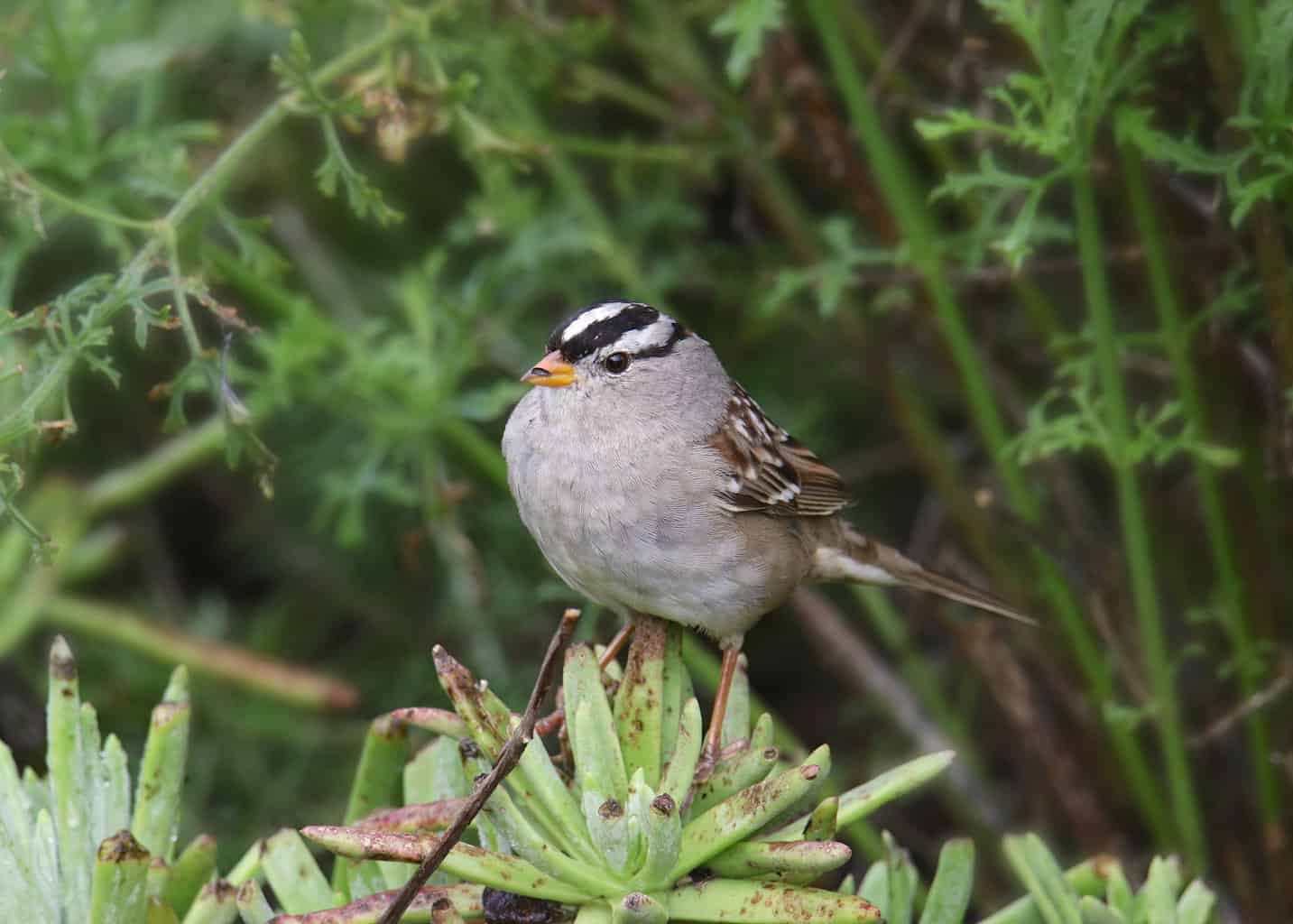
- Scientific name: Zonotrichia leucophrys
- Order: Passeriformes
- Family: Passerellidae
- Length: 6.7-7.5 in (17-19 cm)
- Weight: 0.8-1.5 oz (23-42 g)
- Wingspan: 9.8-11.8 in (25-30 cm)
The White-crowned Sparrow is flashier than many other sparrows on this list. It visits Rhode Island during its spring and fall migration periods, and it is recognizable by its starkly patterned black and white crown.
It is a medium-sized songbird, averaging around 6.5 to 7.5 inches (17 to 19 cm) in length. Its most notable feature is the distinct black and white striped crown on its head, which gives it its name. The body plumage is primarily gray or brownish-gray, with a paler underside. The beak is short and conical in shape, ideal for cracking open seeds. The White-crowned Sparrow has a compact and sturdy build, with a slightly rounded body shape.
Several birds on our list prefer millet to sunflower seeds, but White-crowned Sparrows are easier to attract to a feeder if you include sunflower and other seeds. Their migratory habitat includes weedy fields and thickets, as well as backyards.
Tips & Advice for Spotting Sparrows in Rhode Island
Let’s make sure you have the best possible strategy for spotting Rhode Island’s sparrows.
Choose the Right Habitat
If you’re looking for a specific sparrow, be sure to choose a habitat where they are known to spend time at the time of year. A great starting place is in meadows, wetlands, and shrubby habitats. Many sparrows prefer to stay under thick cover to protect themselves, so thickets and overgrown fields are great.
Familiarize Yourself With Common Sparrow Species
Using our list, you can anticipate what kinds of sparrows you are most likely to see. Because Rhode Island is so small, most sparrows that are present in the state are found throughout the whole state. That means you can narrow down their location by focusing on habitat.
Listen for Songs and Calls
Sparrows are quite expressive, especially in the summer. If you hear a bird, you can use the Merlin App from the Cornell Lab of Ornithology to quickly identify it by song or call. Shy sparrows are often heard before they are seen!
Use Binoculars
Check out our guide to binoculars on the market today! A pair of good binoculars will help you get a closer look at far-away birds. Most importantly, you will be able to take note of the subtle markings and variations in the appearance of sparrows.
You don’t have to buy the most expensive pair of binoculars on the market, but the cheapest tourist trap variety probably won’t help you all that much.
Be Patient
When it comes to birding, patience is a virtue. Sparrows, in particular, are often discreet and elusive. It takes patience to sit, wait, and pay attention to your surroundings in order to find these little birds. If you’re not interested in slowing down and being patient, look for more social sparrows, like House Sparrows, Horned Larks, and Chipping Sparrows.
Be Quiet and Stealthy
Approach the area slowly and quietly, avoiding sudden movements and noise. Sparrows are more likely to reveal themselves if they feel safe, secure, and undisturbed.
Learn Sparrow Behaviors
If you were to go into the woods, looking up at the trees to see sparrows flitting about – you would come home disappointed. Sparrows are far more likely to be found scurrying around the ground, digging in leaf litter, and hiding under brushy cover than they are to be found flying among the treetops. The more you know about sparrow behaviors, the more successful you will be.
Consider Joining a Local Birding Group
Local birding groups can help you connect with experienced birders, who can offer valuable insights, share their knowledge, and lead you to prime bird-spotting locations. Take a look at the record-keeping from the Rhode Island Birds website, which includes annual lists of birds sighted in the state!
Take Notes
Keep a journal or use a good birding app to record your sightings. Be sure to note the date, location, habitat, and any unique behaviors or field marks that you observe.
More Birds to Find in Rhode Island
Whether you have become adept at spotting sparrows or are just ready to try something else, we have several more lists of birds in Rhode Island that you can look for!
Check out our guides to the following birds:
- 9 Hawks in Rhode Island
- 10 Woodpeckers in Rhode Island
- 3 Hummingbirds in Rhode Island
- 20 Ducks in Rhode Island
- 10 Owls in Rhode Island
We hope this article has helped to prepare you for your sparrow-watching adventures in Rhode Island! Have fun!

